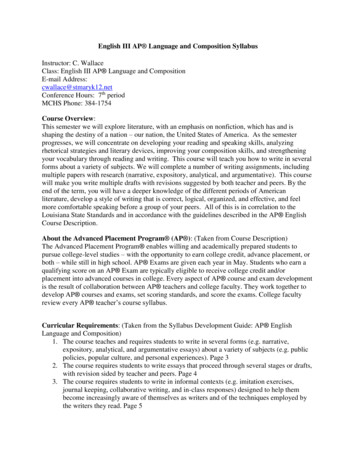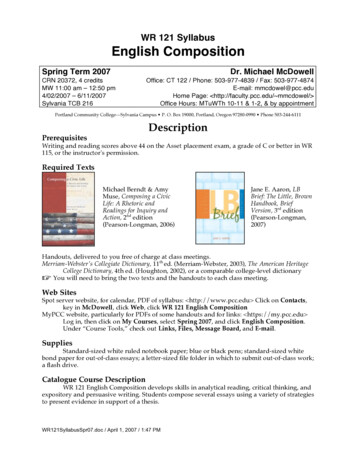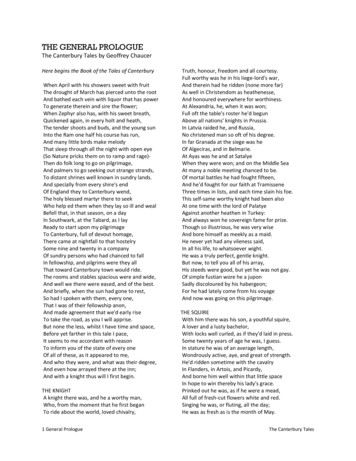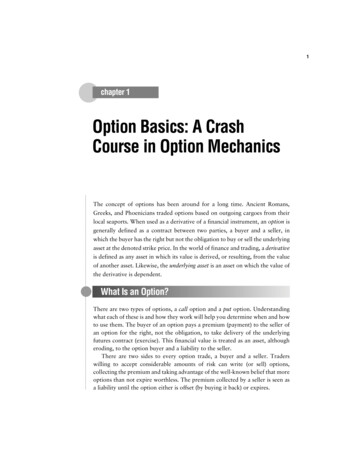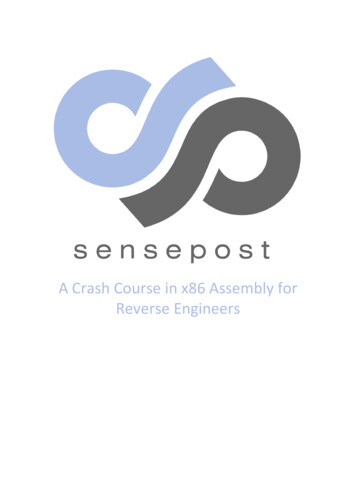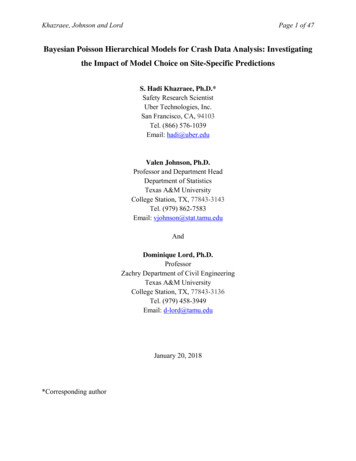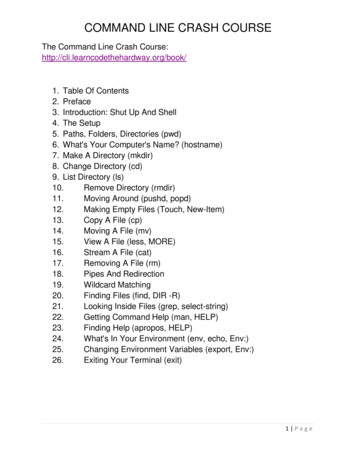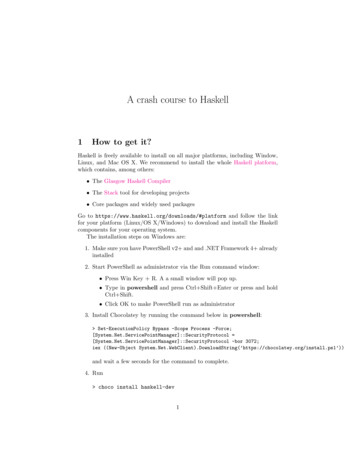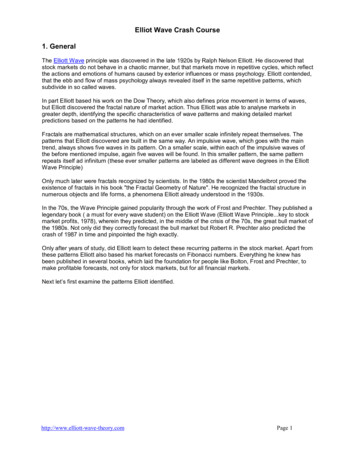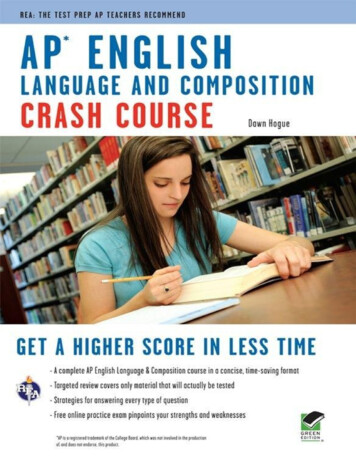
Transcription
Planet Friendly Publishing Made in the United States Printed on Recycled Paper Text: 10% Cover: 10%Learn more: www.greenedition.orgAt REA we’re committed to producing books in an earth-friendly manner and to helpingour customers make greener choices.Manufacturing books in the United States ensures compliance with strict environmentallaws and eliminates the need for international freight shipping, a major contributor toglobal air pollution.And printing on recycled paper helps minimize our consumption of trees, water and fossilfuels. This book was printed on paper made with 10% post-consumer waste. Accordingto Environmental Defense’s Paper Calculator, by using this innovative paper instead ofconventional papers, we achieved the following environmental benefits:Trees Saved: 6 Air Emissions Eliminated: 1,156 poundsWater Saved: 1,075 gallons Solid Waste Eliminated: 341 poundsFor more information on our environmental practices, please visit us online atwww.rea.com/greenResearch & Education Association61 Ethel Road WestPiscataway, New Jersey 08854E-mail: info@rea.comAP ENGLISH LANGUAGE ANDCOMPOSITION CRASH COURSE
Copyright 2011 by Research & Education Association, Inc.All rights reserved. No part of this book may be reproduced in any form without permission of thepublisher.Printed in the United States of AmericaLibrary of Congress Control Number 20109403849780738666068REA is a registered trademark ofResearch & Education Association, Inc.
AP ENGLISH LANGUAGE ANDCOMPOSITION CRASH COURSEAccess Your Exam
Table of ContentsTitle PageCopyright PageAP ENGLISH LANGUAGE AND COMPOSITION CRASH COURSEABOUT THIS BOOKABOUT OUR AUTHORACKNOWLEDGMENTSPART I: - INTRODUCTIONChapter 1 - Keys for Success on the AP English Language and Composition ExamChapter 2 - The Student’s Tools: What You Can Do to Ensure SuccessChapter 3 - Classifying Nonfiction: Genres, Patterns, and PurposesChapter 4 - Representative Authors and TextsPART II: - ELEMENTS OF ARGUMENT, STYLE, AND RHETORICChapter 5 - Basic Elements of LanguageChapter 6 - Rhetoric and Rhetorical StrategiesChapter 7 - Logical FallaciesChapter 8 - The Writer’s Tools: Diction, Tone, Style, Imagery, and Figurative LanguageChapter 9 - Syntax: Sentence Construction and Word OrderChapter 10 - Grammar BasicsPART III: - ANALYTICAL READING AND THINKINGChapter 11 - Engaged and Active ReadingChapter 12 - Enhancing VocabularyChapter 13 - The Value of Perspective: Why Point of View MattersChapter 14 - The World of Ideas: Philosophies, Concepts, and Literary ThemesChapter 15 - Irony and Satire: Reading Between the LinesPART IV: - RESEARCH AND WRITINGChapter 16 - A Prompt Analysis: Ten Years of Free-Response PromptsChapter 17 - Essay Basics: Creating Excellence Through Structure, Style, and VoiceChapter 18 - The Synthesis Question and EssayChapter 19 - Citing and Documenting Sources EffectivelyChapter 20 - Free-Response Question 2: Analyzing a TextChapter 21 - Free-Response Question 3: Arguing Your Own Point of ViewChapter 22 - Six Tips for Better EssaysPART V: - MASTERING THE MULTIPLE-CHOICE SECTIONChapter 23 - General Test-Taking StrategiesChapter 24 - Types of Questions in the Multiple-Choice SectionReferences
Welcome to REA’s Crash Course for AP English Language & Composition
ABOUT THIS BOOKThis AP English Language and Composition Crash Course is the first book of its kind for the lastminute studier or any AP student who wants a quick refresher on the course. REA’s Crash Course isbased on a careful analysis of the AP English Language and Composition Course Description outline andactual AP test questions.Written by an AP English teacher, our easy-to-read format gives students a crash course in the majorelements of language and provides expert advice on writing essays. The targeted review chapters preparestudents for the exam by focusing on the important topics tested on the AP English Language andComposition exam.Unlike other test preps, our AP English Language and Composition Crash Course gives you a reviewspecifically focused on what you really need to study in order to ace the exam. The review chapters offeryou a concise way to learn all the important AP material before the test.The introduction discusses the keys for success and shows you strategies to help you build your overallpoint score. Part Two is an overview of the basic elements of argument, style, and rhetoric. The chaptersfocus on rhetorical strategies, a writer’s tools, syntax, and a refresher on grammar basics.In Part Three, the author highlights analytical reading and thinking tactics, how to enhance yourvocabulary, and gives particular insights into the concepts of irony and satire. Part Four is devotedexclusively to research and writing. Our review of essay basics and an in-depth analysis of the APEnglish Language and Composition essay prompts will help you improve your composition skills.Part Five gives you general test-taking strategies and teaches you how to master the multiple-choicesection of the AP exam. The author explains the types of questions asked and offers tips for success thatwill help you raise your point score.No matter how or when you prepare for the AP English Language and Composition exam, REA’s CrashCourse will show you how to study efficiently and strategically, so you’ll be ready for the exam!To check your test readiness for the AP English Language and Composition exam, either before or after
studying this Crash Course, take our FREE online practice exam. To access your free practice exam,visit www.rea.com/studycenter and follow the on-screen instructions. This true-to-format test featuresautomatic scoring, detailed explanations of all answers, and will help you identify your strengths andweaknesses so you’ll be ready on exam day!Good luck on your AP English Language and Composition exam!
ABOUT OUR AUTHORDawn Hogue has taught all levels of high school English and is currently an AP English teacher for theSheboygan Falls School District, Sheboygan Falls, Wisconsin. She has been given numerous awards andrecognition for her role in the classroom.Ms. Hogue received her B.A. in English, graduating Summa Cum Laude, from Lakeland College,Sheboygan, Wisconsin. She earned her M.A. in Education from Lakeland College, Sheboygan, Wisconsin,and her M.S. in Educational Leadership from Cardinal Stritch University, Milwaukee, Wisconsin.She is interested in promoting technology and web resources in the classroom and maintains a website(www.mshogue.com) for that purpose. The AP English Language and Composition Crash Course is thesecond Crash Course Ms. Hogue has written for REA. She is also the author of the AP EnglishLiterature and Composition Crash Course.
ACKNOWLEDGMENTSIn addition to our author, we would like to thank Larry B. Kling, Vice President, Editorial, for his overallguidance, which brought this publication to completion; Pam Weston, Publisher, for setting the qualitystandards for production integrity and managing the publication to completion; Diane Goldschmidt, SeniorEditor, for editorial project management; Alice Leonard, Senior Editor, for preflight editorial review;Rachel DiMatteo, Graphic Artist, for page designs, and Weymouth Design, for designing our cover.We also extend our special thanks to Elizabeth Catalfamo for copy-editing, and Kathy Caratozzolo ofCaragraphics for typesetting this edition.
PART I:INTRODUCTION
Chapter 1Keys for Success on the AP English Language andCom position ExamThere are no secrets to success. It is the result of preparation, hard work, and learning from failure.—Colin Powell
OVERVIEWCongratulations! You have chosen to enhance your AP English Language study with the help of thisCrash Course. You are a person who wants to know more and go further. That speaks well of your intentto do what it takes to succeed. In the chapters that follow, you will get content-specific help, tips forsuccess, and general insight about what you need to know to be successful on the AP English Languageand Composition exam. This chapter gives you a glimpse into the structure and scoring of the exam aswell as general ways you can prepare yourself for the big day in May.
STRUCTURE OF THE EXAMPart I: Multiple Choice—There are approximately 4-5 passages to read and 55 multiple-choicequestions to answer in 60 minutes. This section represents 45 percent of your total score.Part II: Free Response—You are given a 15-minute reading period, then 120 minutes to write threeessays, one of which is the synthesis essay. This section represents 55 percent of your total score.Test proctors will give a ten-minute break between Part I and Part II. Your AP English Language andComposition instructor is not allowed to proctor your exam.
SCORING OF THE EXAMThe multiple-choice section of the exam is scored by machine.The three essays are scored by College Board readers in early June. Readers include collegeprofessors and experienced AP English teachers, who meet for this purpose. These readers score essaysusing scoring guides created by the College Board’s test development committee for this exam. Youressay is not identified by name or geographical location.The scores from Part I and II are combined to create a composite score. See how to estimate your scorelater in this chapter.Scores are reported to students and designated colleges in July.
AP SCORE SCALE5Extremely well qualified4Well qualified3Qualified2Possibly qualified1No recommendationQualification is to receive college credit or advanced placement.In their information to students, the College Board writes that, “You may be very surprised to see thatyour composite score can be approximately two-thirds of the total possible score and you could still earna grade of 5!” Earning that score on other exams might translate to an “F” at worst and a “D” at best. Inother words, you do not have to get all the multiple-choice questions correct or write perfect essays to geta high score on the exam.In the 2007 figures reported by the College Board, 59 percent of all students who took the exam scoreda 3 or higher. And while fewer than 10 percent of students scored a 5 in 2007, which says a bit about thedifficulty of the exam, you should focus on the high number who passed. A score of 3, 4, or 5 willcommonly earn you college credits but always check with your intended colleges for their AP creditpolicy.2007: ENGLISH LANGUAGE GRADE DISTRIBUTIONS
IMP ORTANT NOTEAccording to the College Board, “Beginning in 2011, total scores on the multiple-choice section arebased on the number of questions answered correctly. Points are no longer deducted for incorrect answersand, as always, no points are awarded for unanswered questions.” The scoring method for essays remainsunchanged. The formula below reflects this change.
ESTIMATING YOUR SCOREThe following form is intended to help you estimate your score when using practice exams. It can onlygive a general prediction and should not be taken too seriously as an indicator of your potential success.For one thing, if you are scoring your own essays, you may be too hard on yourself. Also, ranges forcomposite scores can change from year to year as the exam itself changes. The model below is based on52 questions in Part I.
PART I: MULTIP LE-CHOICE
PART II: F REE-RESP ONSEEssay 1: 3.0556 (do not round up)Essay 2: 3.0556 (do not round up)Essay 3: 3.0556 (do not round up)
ESTIMATING YOUR COMP OSITE SCORE:
TRANSLATING YOUR COMP OSITE SCORE INTO AN APGRADE:Co mpo s it eSc o reAPG ra de112–150598–111480–97355–7920–541
WHAT TO K NOW AB OUT EXAM DAYWhat you can (should have) and cannot have in the exam room:Ye sNoSeveral No. 2 pencils, sharpened, with gooderasersCell phones, MP3 players, or any otherelectronic devices, including calculatorsOne or two reliable dark blue or black pens; avoidpens that clump or bleed.Cameras or other recording devicesA watch, so you can monitor your time. Make sureit does not beep or have an alarm.Books, including dictionariesYour Social Security numberScratch paperNotes you’ve made in advanceHighlighters
P REPARING YOURSELF P ERSONALLY1. Eat well in the weeks prior to the exam. Get used to eating breakfast, so that you can eat a goodbreakfast on exam day since the AP English Language exam is generally scheduled in the morning. Agood breakfast for your brain consists of fruit, lean protein, and complex carbohydrates. Also, drinkwater instead of sugared drinks. Energy drinks are notoriously loaded with sugar and should beavoided.2. Get enough sleep and not just the night before the exam. Establish good sleep patterns in the weeksprior to the exam. Teens typically do not get enough sleep. Aim for 8–9 hours a night.3. Wake up early enough to be fully awake and ready to go on exam day. Set your alarm so you don’toversleep. You don’t want to be groggy!4. Caffeine may help you be more alert, but overdoing it can make you jittery and make it hard for youto focus. If you are not accustomed to caffeine, you shouldn’t have any on exam day.5. Wear comfortable clothes and shoes on the day of the exam. Prepare for fluctuations in roomtemperature by wearing layers that you can adjust.See more in Chapter 2 about what you can do to prepare for exam day.
Chapter 2The Student’s Tools: What You Can Do to EnsureSuccessDiligence is the mother of good luck.—Benjamin Franklin
OVERVIEWAny study text is useless if you don’t pair it your best intentions. This brief chapter simply outlineswhat you can do to enhance your own success.
A STATE OF MIND: THE 3 D’s
DESIRE:This book can only help so much. You have to want to be successful. Your desire to do well musttranslate into your determination and diligence. In addition, your desire must be combined with a positiveand energetic attitude. You have chosen this task because you desire to push yourself. It won’t be easy, butmost things worthy of our time are not easy.
DETERMINATION:Whether or not you are using this book with a structured AP course, you have a lot to accomplish. Nobook or teacher can do for you what you need to do for yourself. You must be resolute in yourdetermination to accomplish your goals.
DILIGENCE:You have to keep at it, even when things get tough.Make a bracelet to wear that displays the three Ds to remind you about the importanceof your state of mind. If you ever feel like slacking, your bracelet can remind you to putyour all into the effort. You can also add Ben Franklin’s quotation, shown at thebeginning of this chapter, for inspiration.
A MATTER OF TIMEYou may have heard the saying, “What’s worth doing, is worth doing well.” This is so true for yourpreparation for the AP English Language and Composition exam. While the title of this book is APEnglish Language and Composition Crash Course, it will be very difficult for you to literally cram in ashort period of time. The information and tips you get in this book will help you either way, but it is bestif you start early enough to really learn what you need to know. Except for some literary terms, there islittle in this text that you can actually memorize. Instead, you need to develop your reading, writing, andthinking skills.It is best to give yourself at least six to nine months to prepare for the exam. If that is not possible, thena few weeks of serious review with this book will definitely help you earn a higher score on the exam.
SUGGESTED STRATEGIES F OR USING THIS B OOK1. Read the entire book, making notes about which chapters seem most necessary for you to study.Focus on what you need to know instead of what you already know.2. Make a goal sheet, listing specific tasks for the upcoming months. Examples of these tasks might be:Read and study several texts, maybe two books and four articles (See Chapter 4 for a list ofauthors and texts.)Practice annotating all the texts I read.3. Good goals have time limits, so be sure to say when you plan to meet your goals.4. Re-read this book as often as necessary to reinforce ideas. Most people will not remembereverything they read the first time.5. Make a short list of the five most important skills you need to improve before test time, such asreading complex texts or understanding satire. Find ways to practice those skills.6. Form a study team with friends who are also taking the exam. Learn from each other. Here are somereasons to form a study team:Quizzing each other on terms can help you remember them.You can share your essays with your group. Peer review can help you see strengths andweaknesses in your writing, and by reading others’ work, you can learn from them as well.If you all read the same books, you can discuss them, which helps to understand a text morecompletely.7. If you get frustrated, try these strategies:Analyze the reason for your frustration. Why are you frustrated? What can you do to lessen howyou feel?Take a short break to refocus: go for a walk outdoors, without headphones. Let nature (or thecity) help you get out of yourself for awhile.Talk to your study group and vent, but then find ways together to get back on track.Ask your teacher for help.
MORE TIP SPenmanship counts! Not everyone has good penmanship, but in preparation for the exam, you shoulddo as much as you can to improve your penmanship. If you do not write legibly on your essays, youare jeopardizing your score. You cannot expect tired, overworked AP exam readers to struggle withyour essay needlessly because they cannot read your handwriting. When you write your practiceessays, always use blue or black ink and always write with an imagined reader in mind.This exam is about scholarship. You should think of yourself as you embark on this “quest” as anupper-level scholar—a college student, really. If you wear the garb of a scholar, evenmetaphorically, it will influence how you think about things.Your attitude is more important than you think—it influences everything, even your physical wellbeing. A positive attitude will give you energy and confidence. A negative attitude will:—Limit your ability to read carefully (you’ll want to rush, skim, or get it over with);—Lead to frustration and fatigue;—Keep you from having an open mind;—Possibly infect others, giving them doubt about their own abilities.You need to study hard and take the exam seriously. However, this is just one test of what you knowat one point in your life. It is not the most important thing you will ever do. So try to keep it all inperspective. Try to have fun with all of this.
Chapter 3Classifying Nonfiction: Genres, Patterns, andPurposesWriting is writing, and stories are stories. Perhaps the only true genres are fiction and non-fiction.And even there, who can be sure?—Tanith Lee
OVERVIEWThe word “genre” means type, and there are many and diverse types of literature in the nonfictionrealm, which seems to change daily, especially with Web tools like Facebook and Twitter. Are profileupdates or Tweets considered genres? Some of you have probably read multi-genre novels, like Avi’sNothing But the Truth and have seen how authors weave nontraditional forms with more traditionalnarratives to create interesting and new types of fictional texts.Nonfiction authors have also blurred the line between fiction and nonfiction in the latter part of thetwentieth century, blending the elements of fiction (imagery, figurative language, suspense, and evendialogue) with nonfiction prose. In general, this blend is called creative nonfiction.The essay itself is said to have originated with French writer Michel de Montaigne, whose short, topicfocused essays set the standard for what followed. For Montaigne, the act of writing the essay was the actof discovering knowledge. He was writing to know, and this may also be your essay experience on the APEnglish Language and Composition exam, as you will be pondering and writing about topics that you maynot normally think about in your daily life.To that end, the exam presents you with many engaging texts to read, think about, and write about. Itwould be nearly impossible to predict the actual genres of the texts you’ll encounter on your exam, as thefield is so rich and diverse. Surely, whatever the selections are, you can be certain that they will be“stylistically engaging” and “intricately constructed,” according to the College Board’s CourseDescription.What does this mean? Mostly it means that while the texts should prove interesting (topically), theywill present a challenge for you. They will be complex enough to put your thinking to the test, which is thepoint, after all, isn’t it?One purpose of this chapter is to suggest the types of literature that you may encounter on the exam andto briefly describe them. There generally are one or two questions on the exam that ask you to identify aspecific genre. This will help. In the “old days,” non-fiction meant biography, autobiography, factualreference, essay, and a few more. These days, the list is much longer. Which genre are you most interestedin reading? If you think a memoir sounds interesting, you might pick up that copy of The Year of MagicalThinking by Joan Didion from your mother’s bookshelf. It wouldn’t be a bad start to your study.
This chapter details the specific patterns of exposition that you are likely to encounter in your reading.You should also be able to use these patterns in your own writing. See Chapter 17 for more on generalessay writing.In addition, there is a brief look at journalism through the years. Many writers featured on the exam arejournalists. However, the timeline doesn’t actually list famous journalists. Instead, it gives you a glimpseof how American news gathering and dissemination has evolved over the years. Today’s journalists domore than write articles and columns. Some of them have helped make blogging a respected genre.
GENRE LISTThe following list is not complete, but does include the genres you are most likely to encounter on theexam based on a study of released exams. No matter what the genre, the writer’s purposes can be layeredand often are. A diary can provide information, chronicle a life, and also describe and persuade. Theletters John and Abigail Adams wrote to each other tell us more than details of their lives; these lettersare also important historical documents.Remember also that fictional elements are now used widely in nonfiction, an overlap that makes itdifficult to determine exact distinctions between the two.G e nreAt t ribut e s & No t e sAllegoryAllegory tells a literal story by using another story, a figurative one, to createambiguity. Jonathan Swift’s Gulliver’s Travels is social criticism and satire veiledas a fantastical tale of strange lands and peoples.AutobiographyAn author’s story of his or her own life; written in first person. Varies from memoirin that it generally reads less like a novel (as memoirs often do) and more like achronological account, though there are no rules for either.BiographyA third-person account of another’s life.Blog Post (orWeblog Post)An entry on a personal or professional website called a blog; can be on any topic,from any point of view, and written for various audiences, various purposes. Truly ademocratic genre; anyone can write a blog.CreativeNonfictionA relatively new genre, creative nonfiction tells true stories using the tools fictionwriters use, such as plot narratives, imagery, dialogue, and more. Topics arediverse, from personal narrative to travelogues, and more.Critique(Criticism)Similar to a review, a critique points out the strengths and weaknesses of a work(art, literature, speech, performance, etc.).DebateA traditional debate is a spoken event in which participants (two opposing teams)argue (with supporting details) a controversial issue. Political debates featurecandidates (sometimes only two, sometimes many) who give their own point ofview on current topics.Diary(journal, log)An account that is kept daily, or almost daily, by an individual to record events ofhis/her life and to express his/her views.ExcerptA short portion of a larger text meant to stand on its own. You may be asked to inferthe broader context of an excerpt, such as from what genre it was excerpted or the
identity of the intended audience.EditorialWritten by the editor of a newspaper, traditionally, it expresses the view of theeditor or the editorial staff on an issue prominent in the news. An editorial istypically short (300–350 words) and generally persuasive.EyewitnessAccountA first-person report (primary source) of an individual who witnesses an importantor significant event. As each person’s point of view is affected by a wide variety oflimiting factors, more than one account is desired for a more objective view ofreality.FableA narrative meant to teach a lesson in which the characters are sometimes animalrepresentatives of human types or specific human beings, especially if used forsatirical purposes.History/HistoricalCommentaryA history is a factual account of an event or period in time. A historical commentaryis one person’s view of that event, so opinion is based on research, fact, orobservation.HomilyA sermon or a lecture, generally narrative in style, with a moralizing (didactic)purpose.ImageGraph, chart or other infographic. Could also be a photograph or other type of visualimage.Letter(epistle)Letters can take various forms, from business letters to personal correspondence.The genre now seems nearly obsolete due to e-mail, but historically letters werepreserved. Letters from writers, politicians, artists, and others are viewed ashistorical documents or even as literary works. Letters are also written for a widevariety of purposes: to inform, persuade, entertain, satirize, criticize, and more. Theterm “epistolary style” means in letter form.LiteraryCriticismBeyond a review, a literary criticism measures a work of literature against currentstandards; an analysis of a work that investigates a certain aspect of the work, suchas symbolism or irony. Literary criticism may also discuss the work as seen througha specific literary theory, such as feminist, Freudian, or Marxist.MemoirA personal narrative that reflects upon one’s own life experiences. May be lesschronological and encompassing than a typical autobiography.MonologueOne voice, generally first-person, narrates a train of thought or consciousness onone topic. Typically spoken, as on the stage for an audience.PersonalReminiscenceFirst-person account of a particular event in time.PoliticalCartoonGenerally a one-celled comic, the political cartoon is primarily satire, which hopesto point out inadequacies or corruption in the political sphere.
ReviewGives the writer’s informed opinion about the quality of literary works, movies orother visual media, art, music, even restaurants. Reviewers are called critics.SatireThe satirist seeks to improve society by showing its faults through irony and humor,either with a friendly nudge or sharp-edged jabs. See Chapter 15 for more on satire.SermonA speech given by the clergy to the congregation, typically didactic in nature.SocialCriticismVarious subgenres (satire, essay, speech, etc.) meant to criticize current socialtrends, philosophies, standards, mores, etc.SpeechOral essay, commentary; there is a wide variety of types of speeches. The importantdistinction is that a speech is spoken to an intended audience, which impacts wordchoice, etc.Travelogue/Place EssayThe setting provides the basis for the writing; the author recognizes somethingsignificant in the setting.TreatiseA formal and systematic exposition in writing of the principles of a subject,generally longer and more detailed than an essay.You may be asked to infer the broader context of an excerpt, such as from what genre itwas likely excerpted or the probable identity of the intended audience.
P URP OSES OF ESSAYS (OF WRITING IN GENERAL):While writers may have one main purpose in mind, they may achieve more than one simultaneously.You will be asked to determine the writer’s purpose on the exam, and should choose the author’s main ordominant reason for writing.InformTo give information, clearly and objectively.PersuadeTo convince another to adopt a point of view or engage in an action.EntertainTo provide humor and a pleasant escape.SatirizeTo point out flaws in people or institutions with the intent of making positive change.InspireThrough one’s own experiences or observations, provide models that guide or give hopeto others.ReflectTo think back upon, to put into perspective. Reflection is typically personal, but thinksof the self in relation to others, to history, or to events in time.DocumentTo mark in time, to record the significance of some event or action.
TYP ES (PATTERNS) OF ESSAYSPa t t e rnPurpo s eAnalogyTo explain something abstract or complex by showing its similarity to somethingsimpler and more concrete. For the analogy to be effective, the writer shouldassume that the reader is familiar with the subject. The main purpose of the analogyis to explain.Cause andEffectThe writer wishes to explain why. Types of causes are the immediate causes,which are encountered first, and the ultimate causes, which are the basic,underlying factors that explain the more apparent causes. Example: Mom was latefor work today because she overslept (immediate cause). She didn’t sleep wellbecause she was worrying about her annual employment review and hoped herboss would not bring up the obvious dip in quarterly sales, which she wasprepared to explain was due more to the economic recession than her ad campaign(ultimate cause). In writing a logical cause and effect essay, the writer mustconsider all possible relevant factors. There must be evidence for all assertionsand attention to objectivity.ClassificationThe author divides the subject into categories or other systems to analyze thematerial, such as types, si
ABOUT THIS BOOK This AP English Language and Composition Crash Course is the first book of its kind for the last-minute studier or any AP student who wants a quick refresher on the course. REA’s Crash Course is based on a careful analysis of the AP English Language and Composition Course Description outline and actual AP test questions.File Size: 2MB
